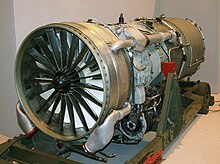Rolls-Royce Conway
The Rolls-Royce Conway was the world's first turbofan engine used in aviation ( turbofan or twin- flow jet engine ). The development of Rolls-Royce was co-financed by the British government and began in 1952 under the designation RB.80. The engine's maiden flight took place in 1954 with an Avro Ashton .
Compared to the previous single-flow jet engines ( turbojet ), the Conway was significantly quieter and also more economical. The bypass ratio was initially very low at 0.3. The first series delivered a thrust of 77.6 kN , which, however, could be increased to 97.8 kN in the course of further development.
The engine was produced in several versions for the civil and military sectors and was also available with reverse thrust mechanisms . The Conway was used on the Handley Page Victor , the Vickers VC-10 and some types of the Boeing 707 and Douglas DC-8 . It was one of the first jet engines with an MTBO of 10,000 hours.
The direction taken with the sidestream turned out to be the right one, and so the Conway was replaced by the first real fan engine, the Rolls-Royce RB.178 and later by the Rolls-Royce RB211 .
In the US market, the Conway could not prevail against the engines from Pratt & Whitney and so the economic success remained modest.
Technical specifications
Conway Mk. 540:
- Weight: 2310 kg
- Thrust: 90.6 kN
- Tube ring combustion chamber with ten combustion chambers
- Compressor: nine-stage axial compressor
- Turbine: single-stage high-pressure axial turbine and two-stage low-pressure axial turbine
